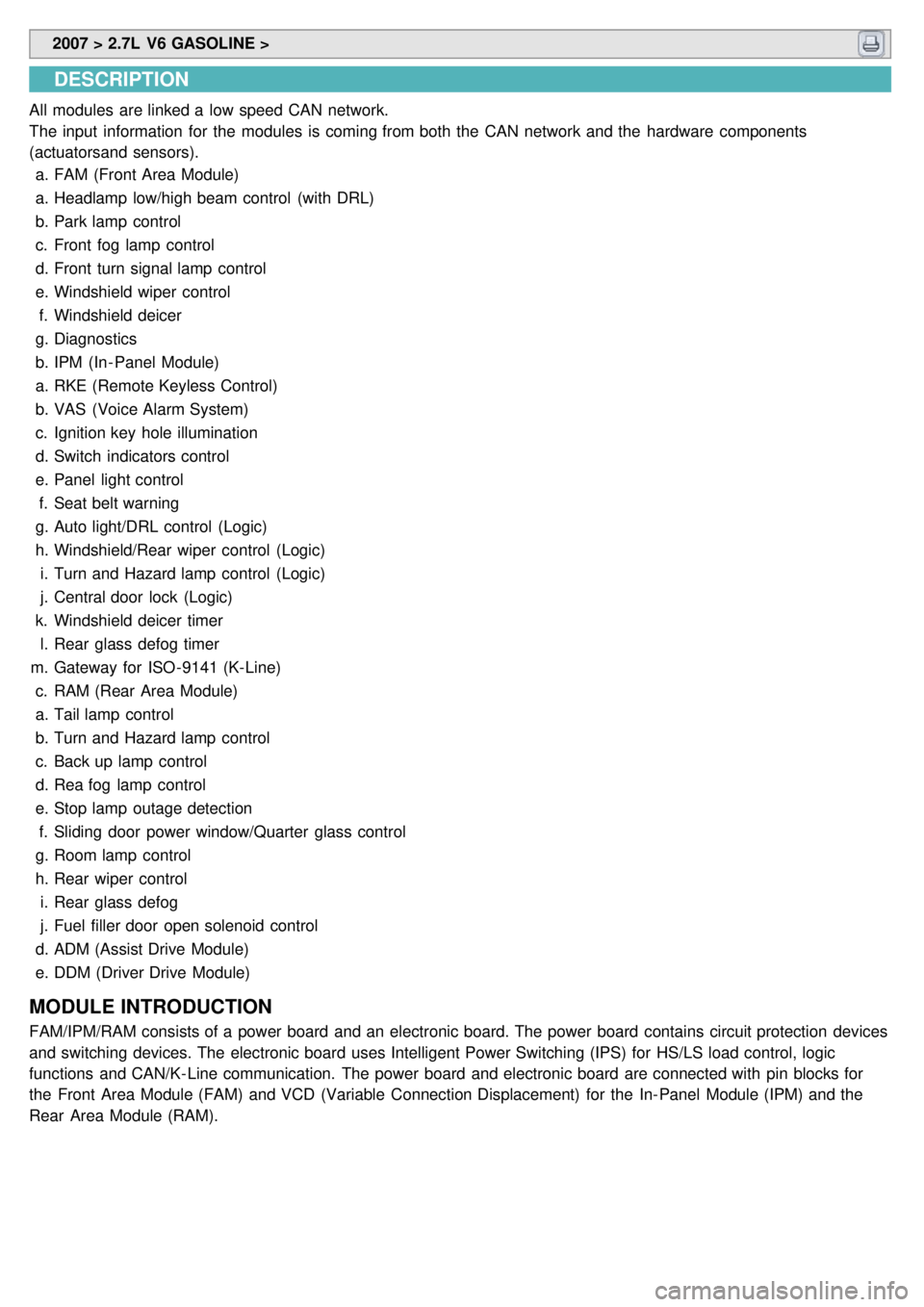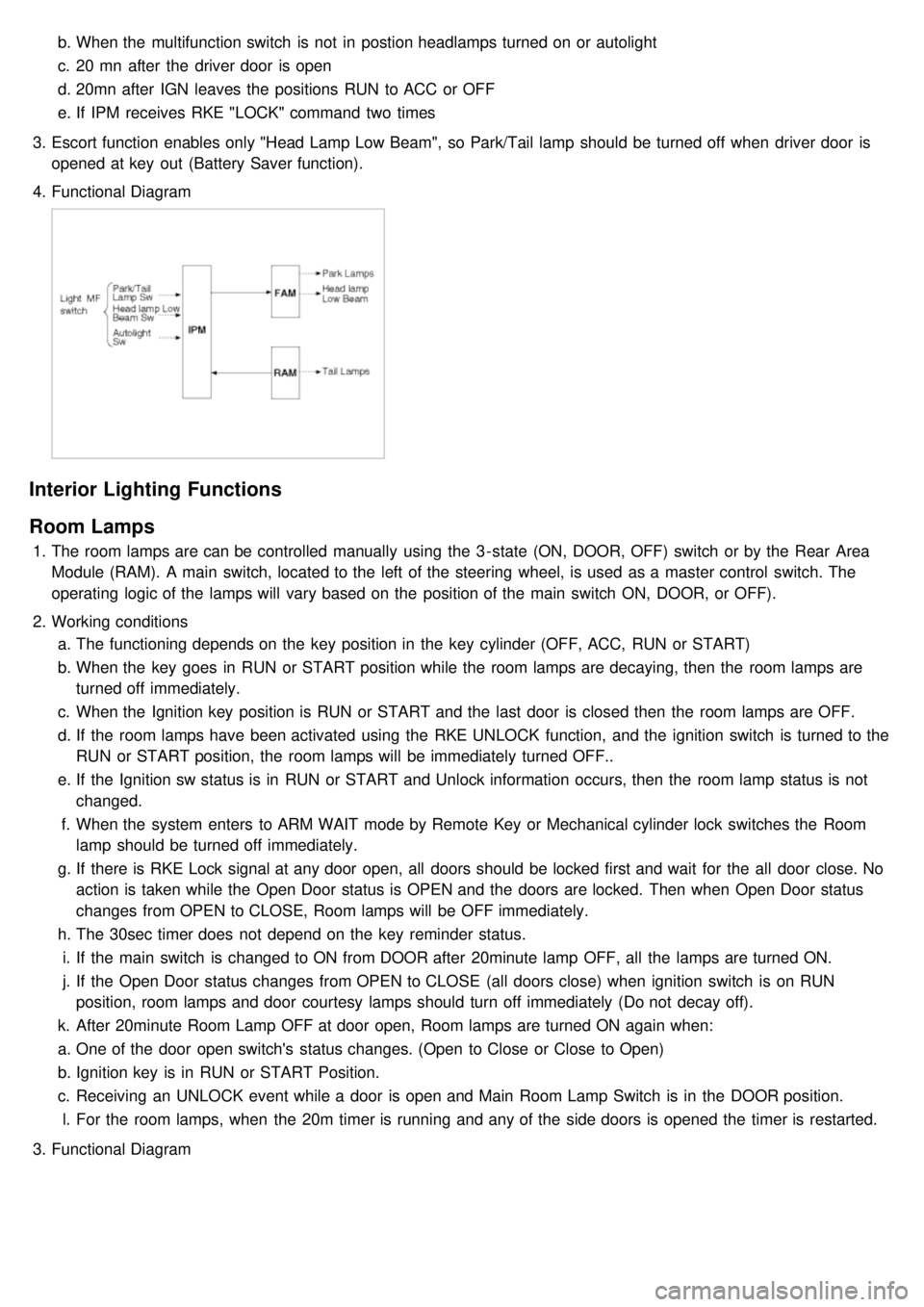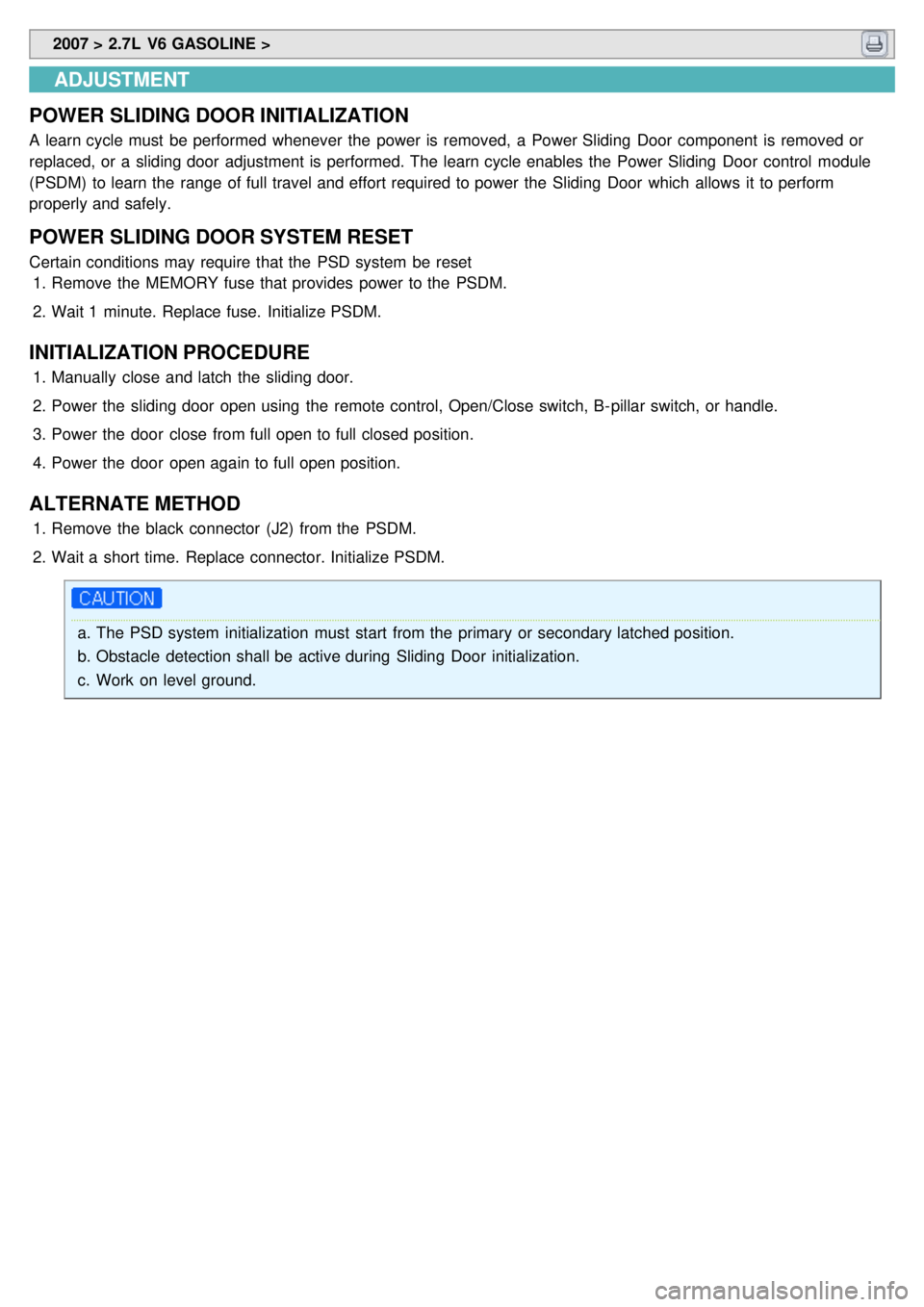Page 1187 of 1575
Page 1189 of 1575
2007 > 2.7L V6 GASOLINE >
REPLACEMENT
1.Disconnect the negative ( - ) battery terminal.
2. Remove the driver airbag module(A). (Refer to the airbag group).
3.Remove the audio remote control switch (A) after removing the steering wheel remote control switch connector and
2 screws.
4.Installation is the reverse of removal.
INSPECTION
1.Check for resistance between No.2 and No.3 terminals in each switch position.
Switch Connector terminal Resistance (±5%)
MODE 2 - 3 (Left) 2.11 kΩ
MUTE 2 - 3 (Left) 3.11 kΩ
VOLUME UP 2 - 3 (Left) 4.61 kΩ
VOLUME DOWN 2 - 3 (Left)5.81 kΩ
Page 1211 of 1575

2007 > 2.7L V6 GASOLINE >
DESCRIPTION
All modules are linked a low speed CAN network.
The input information for the modules is coming from both the CAN network and the hardware components
(actuatorsand sensors).
a. FAM (Front Area Module)
a. Headlamp low/high beam control (with DRL)
b. Park lamp control
c. Front fog lamp control
d. Front turn signal lamp control
e. Windshield wiper control
f. Windshield deicer
g. Diagnostics
b. IPM (In - Panel Module)
a. RKE (Remote Keyless Control)
b. VAS (Voice Alarm System)
c. Ignition key hole illumination
d. Switch indicators control
e. Panel light control
f. Seat belt warning
g. Auto light/DRL control (Logic)
h. Windshield/Rear wiper control (Logic)
i. Turn and Hazard lamp control (Logic)
j. Central door lock (Logic)
k. Windshield deicer timer
l. Rear glass defog timer
m. Gateway for ISO- 9141 (K- Line)
c. RAM (Rear Area Module)
a. Tail lamp control
b. Turn and Hazard lamp control
c. Back up lamp control
d. Rea fog lamp control
e. Stop lamp outage detection
f. Sliding door power window/Quarter glass control
g. Room lamp control
h. Rear wiper control
i. Rear glass defog
j. Fuel filler door open solenoid control
d. ADM (Assist Drive Module)
e. DDM (Driver Drive Module)
MODULE INTRODUCTION
FAM/IPM/RAM consists of a power board and an electronic board. The power board contains circuit protection devices
and switching devices. The electronic board uses Intelligent Power Switching (IPS) for HS/LS load control, logic
functions and CAN/K- Line communication. The power board and electronic board are connected with pin blocks for
the Front Area Module (FAM) and VCD (Variable Connection Displacement) for the In- Panel Module (IPM) and the
Rear Area Module (RAM).
Page 1218 of 1575

b.When the multifunction switch is not in postion headlamps turned on or autolight
c. 20 mn after the driver door is open
d. 20mn after IGN leaves the positions RUN to ACC or OFF
e. If IPM receives RKE "LOCK" command two times
3. Escort function enables only "Head Lamp Low Beam", so Park/Tail lamp should be turned off when driver door is
opened at key out (Battery Saver function).
4. Functional Diagram
Interior Lighting Functions
Room Lamps
1.The room lamps are can be controlled manually using the 3 - state (ON, DOOR, OFF) switch or by the Rear Area
Module (RAM). A main switch, located to the left of the steering wheel, is used as a master control switch. The
operating logic of the lamps will vary based on the position of the main switch ON, DOOR, or OFF).
2. Working conditions
a. The functioning depends on the key position in the key cylinder (OFF, ACC, RUN or START)
b. When the key goes in RUN or START position while the room lamps are decaying, then the room lamps are
turned off immediately.
c. When the Ignition key position is RUN or START and the last door is closed then the room lamps are OFF.
d. If the room lamps have been activated using the RKE UNLOCK function, and the ignition switch is turned to the
RUN or START position, the room lamps will be immediately turned OFF..
e. If the Ignition sw status is in RUN or START and Unlock information occurs, then the room lamp status is not
changed.
f. When the system enters to ARM WAIT mode by Remote Key or Mechanical cylinder lock switches the Room
lamp should be turned off immediately.
g. If there is RKE Lock signal at any door open, all doors should be locked first and wait for the all door close. No
action is taken while the Open Door status is OPEN and the doors are locked. Then when Open Door status
changes from OPEN to CLOSE, Room lamps will be OFF immediately.
h. The 30sec timer does not depend on the key reminder status.
i. If the main switch is changed to ON from DOOR after 20minute lamp OFF, all the lamps are turned ON.
j. If the Open Door status changes from OPEN to CLOSE (all doors close) when ignition switch is on RUN
position, room lamps and door courtesy lamps should turn off immediately (Do not decay off).
k. After 20minute Room Lamp OFF at door open, Room lamps are turned ON again when:
a. One of the door open switch's status changes. (Open to Close or Close to Open)
b. Ignition key is in RUN or START Position.
c. Receiving an UNLOCK event while a door is open and Main Room Lamp Switch is in the DOOR position.
l. For the room lamps, when the 20m timer is running and any of the side doors is opened the timer is restarted.
3. Functional Diagram
Page 1324 of 1575
Secondary Obstacle Detection is provided by means of a contact type strip. Strip is composed of two conductive
zones separated by an air gap. When strip is compressed, conductive zones make contact, activating the switch
signal.
Copper wire is extruded through conductive material to prevent resistive buildup. Terminating resistor is molded into
end of strip to detect failures of strip.
5.OVERHEAD CONSOLE AND REMOTE CONTROL SWITCH (A)
The power sliding doors can be opened and closed automatically with the RKE and the main control button on the
overhead console.
6.DOOR LATCH (B)
The door latch contains a detent switch [C] used to detect the latch state and report the latch state to the power
sliding door module.
7.KEYLESS ENTRY (A)
Power sliding doors can be opened and closed by pressing the button on the RKE more than 0.5 sec. Open
operation shall be reserved when an additional open/close signal is received during power opening.
Page 1336 of 1575

2007 > 2.7L V6 GASOLINE >
ADJUSTMENT
POWER SLIDING DOOR INITIALIZATION
A learn cycle must be performed whenever the power is removed, a Power Sliding Door component is removed or
replaced, or a sliding door adjustment is performed. The learn cycle enables the Power Sliding Door control module
(PSDM) to learn the range of full travel and effort required to power the Sliding Door which allows it to perform
properly and safely.
POWER SLIDING DOOR SYSTEM RESET
Certain conditions may require that the PSD system be reset 1. Remove the MEMORY fuse that provides power to the PSDM.
2. Wait 1 minute. Replace fuse. Initialize PSDM.
INITIALIZATION PROCEDURE
1.Manually close and latch the sliding door.
2. Power the sliding door open using the remote control, Open/Close switch, B- pillar switch, or handle.
3. Power the door close from full open to full closed position.
4. Power the door open again to full open position.
ALTERNATE METHOD
1.Remove the black connector (J2) from the PSDM.
2. Wait a short time. Replace connector. Initialize PSDM.
a.The PSD system initialization must start from the primary or secondary latched position.
b. Obstacle detection shall be active during Sliding Door initialization.
c. Work on level ground.
Page 1377 of 1575
2007 > 2.7L V6 GASOLINE >
ADJUSTMENT
POWER TAIL GATE INITIALIZATION
POWER TAILGATE SYSTEM RESET
Certain conditions may require that the PTG system be reset. 1. Remove the MEMORY fuse that provides logic power to the PTGM.
2. Wait 1 minute. Replace fuse. Initialize the PTGM.
INITIALIZATION PROCEDURE
The Power Tailgate system initialization must start from the full closed or latched position. The Tailgate must be
powered Open once to fully initialize the system (Obstacle detection shall be active during Tailgate initialization).
1. Manually close and latch the Tailgate.
2. Power the Tailgate open using the Open/Close switch, outside handle or the remote control.
ALTERNATE METHOD
1.Remove the black connector (J2) from the PTGM.
2. Wait a short time. Replace connector. Initialize PTGM.
a.The PTG system initialization must start from the primary or secondary latched position.
b. Obstacle detection shall be active during system initialization.